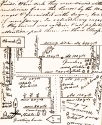This exhibition is an overview of the Woodstock Theological Library, from its founding as part of Woodstock College in 1869 to the present. On display are images of Woodstock's founders, including the first librarian. Also featured are printed volumes of The Woodstock Letters , which are of historical importance in that they document the growth and activities of the Jesuits in the United States.
The Founding of Woodstock College
Woodstock and Its Makers
Written by Patrick J. Dooley, S.J., Woodstock and Its Makers was published in 1927 and remains the best comprehensive source for the history of the founding of the Woodstock College.
Father Joseph E. Keller
Joseph E. Keller, S.J., shown here, was the founder of the Woodstock Letters, a publication that ran from 1872 to 1969. The letters contained news from Jesuit missions within the United States and abroad covering China and Japan and eventually all of the Americas. By the 1940s the publication increasingly covered the Jesuits’ enterprises of historical research and other intellectual pursuits. “Many intellectual historians consider the founding of Woodstock Letters to be one of the four superior achievements of late nineteenth-century Catholic literature.” (Carriker, p. 6)
The First and Last Issues of the Woodstock Letters
The Library of Woodstock College
The Library of Woodstock College was, as it is now, an outstanding resource for training in theology. The first librarian, shown here, was Emilius M. De Augustinis. Besides his post as the librarian, he was also a scholar of Thomas Aquinas. The tradition of scholar-librarians overseeing the Woodstock Library continues to this day.
The Library in 1893
In the Fordham Monthly from 1893, an anonymous student writer describes Woodstock College. His reflection, in the third person, on the library is of note:
"…Mounting the broad stair-case he was ushered into the Library, a room about thirty feet high, sixty long, and forty wide. With two galleries running round the four walls and every shelf well stocked with volumes, old and new, with rare old works on Philosophy and Theology that descended from the monasteries of the Middle Ages, with manuscript Bibles and mass-books in every known language, with other curiosities in vellum covers that would well repay months of study and prove a delight to the heart of any genuine book-lover, this library must always claim a great share of everyone’s attention."
The Woodstock Theological Library Today
No less “well-stocked” than in 1893, today Woodstock Theological Library (WTL) has more than 190,000 books in circulation. The rare materials of WTL are among the most important in the world for documenting the history of the Jesuit order. One of the library’s most significant items is the first printed edition of The Spiritual Exercises of St. Ignatius from 1548.
Besides the rare materials, the library is a vibrant space for scholars at every level in their formation. Shown here is a research course given by the director of the library, J. Leon Hooper, S.J. who introduces students not only to research methodologies but also gives them the opportunity to experience the original texts produced during St. Ignatius’s lifetime.
Exhibition curated by Amy E. Phillips, Rare Materials Cataloger, Woodstock Theological Library
Photography by David Hagen, Graphic Artist/Photographer, Lauinger Library





